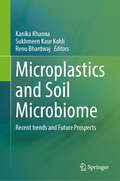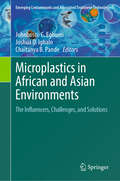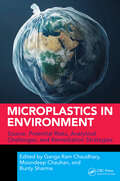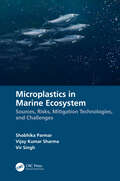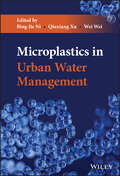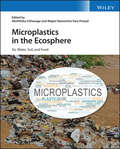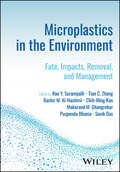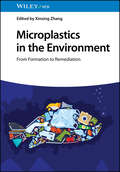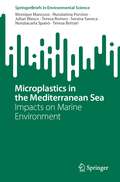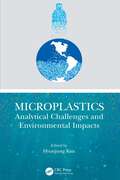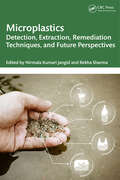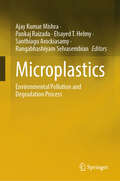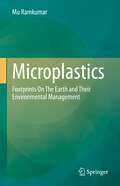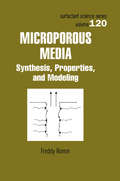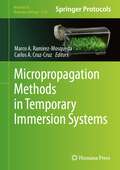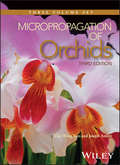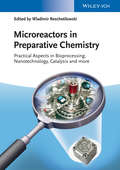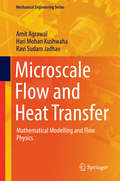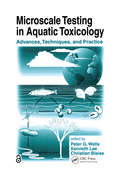- Table View
- List View
Microplastics Pollution in Aquatic Media: Occurrence, Detection, and Removal (Environmental Footprints and Eco-design of Products and Processes)
by Mika Sillanpää Subramanian Senthilkannan Muthu Ali KhadirThis book highlights one of the most important water pollutants known as Microplastics. It has been reported that humans and the environment are dealing with microplastics particles in water and aquatic media. Despite the fact that such pollution might have mainly started out from the sea, it is now in lakes, rivers, ponds and even drinking water. This book presents as overview of microplastics in freshwater environments in different regions around the world. It discusses the ecotoxicological effects of microplastics, the removal/remediation techniques of microplastics and the role of water/wastewater treatment plants in spreading microplastics. This book is a valuable resource, covering wide aspects of microplastics from sources, detection and characterization to removal and their fate in treatment plants.
Microplastics and Pollutants: Interactions, Degradations and Mechanisms
by V. Sivasankar T. G. SunithaThis volume discusses the adsorptive profiles of microplastic (MP) pollutants, covering their structural identity, sorption ability and degradation due to photolytic, hydrolytic, mechanical, and other environmental factors. In addition to the quantitation of (MPs) in the environment, the book unveils the deleterious effects on aquatic species and humans due to adsorbed inorganic/organic contaminants on the surface of MPs. The present book finds its uniqueness by presenting in-depth discussions on the interactions and mechanisms of microplastics with organic pollutants, microalgae, and human systems. The interactions and mechanisms between microplastics and microalgae are explored to understand the possible remediation pathways in microplastic contaminated water resources. Students and researchers in the fields of environmental science and engineering, biotechnology, aquaculture, marine technology, and water chemistry can benefit from this book. Furthermore, industries, NGOs and stakeholders dealing with wastewater, solid waste/environmental pollution will find this book useful.
Microplastics and Soil Microbiome: Recent trends and Future Prospects
by Renu Bhardwaj Kanika Khanna Sukhmeen Kaur KohliThis edited book is a comprehensive collection of information on microplastics and their existence within the environment. The main focus of this book is to address the ecological aspect of microplastics and their degradation of the ecosystem. It deals with the distribution, persistence, fate, and remediation of microplastics with novel strategies such as nanoparticles, beneficial microbes, biofilms, enzymatic processes, bio-nano materials, biotechnological and other sustainable approaches. The widespread presence of microplastics in the environment has led to major concerns, thereby orienting the studies on the interactions within the environment among plants and soil microbiome. The variety and properties of microplastics in the environment make their interactions more complex. The emergence of new ecological sites will also affect the ecosystem of water and soil. This title compiles updated aspects and information about the remediation practices and the fateof microplastics in the environment. The book focuses on eco-friendly, eco-efficiency and novel practices to deal with microplastic pollution. This book is of interest and useful to agricultural professionals, environmentalists, industrialists, field-level extension workers, planters, industrial entrepreneurs, ecologists, and a valuable source of reference to the relevant researchers and students in the region.
Microplastics in African and Asian Environments: The Influencers, Challenges, and Solutions (Emerging Contaminants and Associated Treatment Technologies)
by Chaitanya B. Pande Johnbosco C. Egbueri Joshua O. IghaloThis innovative book tackles the pressing global environmental issue of microplastic pollution, with a particular focus on the diverse and ecologically significant regions of Africa and Asia. Through comprehensive analysis, it unveils the alarming extent of microplastic contamination in these regions, highlighting the urgent need for attention and action. The book provides a thorough introduction to microplastics, exploring their composition, formation process, and mechanisms of infiltration into terrestrial and aquatic ecosystems. It explains their transport mechanisms, their presence in air, water, soil, sediments, wetlands, and their far-reaching ecological impacts on food security and human health. It investigates their direct and indirect effects on public health, including inhalation, ingestion, toxicological implications, and overall consequences. The book also examines the interactions between human activities, socioeconomic factors, and microplastic proliferation across different environmental compartments. Drawing insights from case studies across coastal cities and remote rural areas, the book illustrates the scope and magnitude of this problem in Africa and Asia. Furthermore, it provides an overview of analytical techniques and methodologies employed in microplastic research, such as GIS, remote sensing, spectroscopy, and computational modelling. It meticulously analyzes current mitigation techniques, best practices, policy frameworks, and the role of public awareness in addressing this issue. The book offers insights into future research directions, mitigation strategies, and broader ecological and human health aspects of microplastic pollution. Designed as a graduate-level resource, this interdisciplinary book is invaluable for researchers across disciplines, policymakers working in these regions, and anyone concerned about the pervasive issue of microplastic pollution and its far-reaching consequences across several other regions of the world.
Microplastics in Environment: Source, Potential Risks, Analytical Challenges, and Remediation Strategies
by Moondeep Chauhan Bunty Sharma Ganga Ram ChaudharyIn recent years, the pervasive presence of microplastics in the environment has emerged as a pressing global concern. As we grapple with the complexities of this issue, it becomes increasingly evident that a comprehensive understanding of microplastics' sources, risks, analytical challenges, and remediation strategies is essential for effective mitigation and safeguarding of our ecosystems and human health.Microplastics in Environment comprehensively explores the growing concern surrounding microplastic pollution. From their emergence as a significant environmental pollutant to their potential risks and various remediation strategies, this book delves into every aspect of microplastics' impact on ecosystems and human health. With chapters authored by experts in the field, readers gain insights into the sources, classification, properties, and dynamics of microplastics in different environmental compartments, including marine environments, soils, and indoor settings. Analytical challenges related to the identification, quantification, and characterization of microplastics are thoroughly discussed, along with emerging computational approaches to unravel the microplastic mystery. The book highlights recent trends in using bioindicators to monitor microplastic pollution and its adverse impacts on animal health. Additionally, the book explores trends, challenges, and opportunities in plastic recycling and future directions for addressing microplastics.Microplastics in Environment compiles current knowledge and identifies gaps, serving as a valuable resource for researchers, policymakers, and practitioners working towards a cleaner, healthier planet. It aims to support those dedicated to safeguarding our planet for future generations.FEATURES Focuses on microplastic pollution in the environment and highlights the emergent need to reduce and eliminate microplastic pollution. Includes special chapters on microplastic classifications, estimation tools, and the role of computational modeling in microplastic. Discusses microplastic occurrence in marine, soil, air, and prevention strategies in different environmental settings. Furthermore, it explores different remediation strategies, current trends, challenges, and opportunities in plastic recycling.
Microplastics in Marine Ecosystem: Sources, Risks, Mitigation Technologies, and Challenges
by Vijay Kumar Sharma Vir Singh Shobhika ParmarThis book addresses pertinent issues relating to microplastic pollution including its sources and sink of the microplastics and their environmental fate. It focuses on the impacts of microplastic pollution on marine life and human health. Available conventional methods and future solutions for the prevention and control of the marine microplastic pollution, such as bacterial and marine fungus biodegradation, membrane technology, and bioengineered microbes are included along with limitations and future challenges. Features: Provides detailed insight into the marine microplastics pollution, fate, health impacts, and removal technology Reviews ecological risks and environmental fate of microplastic pollution to the marine ecosystem Describes control and prevention methods of the microplastics pollution Covers global legislature for the mitigation of microplastic to the marine environment Discusses the role of community participation for the reduction of microplastic emissions This book is aimed at researchers and professionals in environmental engineering, science, and chemistry, marine pollution, marine and aquatic science.
Microplastics in Terrestrial Environments: Emerging Contaminants and Major Challenges (The Handbook of Environmental Chemistry #95)
by Yongming Luo Defu HeThis book focuses on microplastics as emerging persistent contaminants in terrestrial environments. Scientists from around the globe review recent advances in multi-disciplinary research on micro(nano)plastics, including analytical methods; the sources, fate and distribution of microplastics; ecological risks; toxicity and health risks; and control and countermeasures for microplastics in terrestrial environments. Offering a comprehensive overview of microplastics in terrestrial environments, the book is a valuable resource for environmental researchers, ecologists and toxicologists, as well as for policymakers and non-experts.
Microplastics in Urban Water Management
by Wei Wei Bing-Jie Ni Qiuxiang XuMicroplastics in Urban Water Management Enables readers to understand the true occurrence and fate of microplastics in drinking water, wastewater and sludge, and receiving water Microplastics in Urban Water Management focuses on the occurrence, fate, effect, and removal of microplastics in the urban water management systems, summarizing relevant methods for enhancing microplastics removal and degradation, providing comprehensive data from source to sink (including occurrence and fate of microplastics in urban water management), and covering practical applications, which are expected to provide some theoretical guidance for controlling or mitigating microplastics pollution and its environmental risks. The work also includes detailed multidisciplinary information on the way in which microplastics behave in urban water management, plus recent advances of nanoplastics, i.e., nano-sized microplastics, in the aquatic environment. In Microplastics in Urban Water Management, readers can expect to find detailed information on sample topics such as: Techniques for microplastics detection, including sample collection, purification, identification, and quantitation, plus the definition, emergence, occurrence, and removal of microplastics Elements of microplastics in wastewater treatment plants; for instance, the ecotoxicological effect on the biological treatment of wastewater and sludge Why the discharge of microplastics from wastewater treatment plants is the important source of microplastics in the receiving waters Potential environmental risks of microplastic contamination in receiving water systems and evidence that microplastics can absorb, collect and transport environmental contaminants as vectors For practicing toxicologists, biologists, environmental and chemical engineers, and ecology professionals, as well as researchers and graduate students in these disciplines, Microplastics in Urban Water Management is an essential all-in-one guide to understanding the current state of microplastics in our world and potential solutions for the future.
Microplastics in the Ecosphere: Air, Water, Soil, and Food
by Majeti Narasimha Vara Prasad Meththika VithanageMicroplastics in the Ecosphere Discover the environmental impact of microplastics with this comprehensive resource Microplastics are the minute quantities of plastic that result from industrial processes, household release and the breakdown of larger plastic items. Widespread reliance on plastic goods and, particularly, single-use plastics, which has been increased by the COVID-19 pandemic, has made microplastics ubiquitous; they can be found throughout the ecosphere, including in the bloodstreams of humans and other animals. As these plastics emerge as a potential threat to the environment and to public health, it has never been more critical to understand their distribution and environmental impact. Microplastics in the Ecosphere aims to cultivate that understanding with a comprehensive overview of microplastics in terrestrial ecosystems. It analyzes microplastic distribution in aerosphere, hydrosphere, and soil, tracing these plastics from their production on land to their distribution—overwhelmingly—in maritime ecosystems. The result is a book that will inform researchers and policymakers as we look to tackle this emerging challenge globally. Microplastics in the Ecosphere readers will also find: Introductory information about the production and distribution of single-use plastics An emphasis on management and mitigation strategies designed to reduce contamination over time A multidisciplinary approach, combining concepts and analytical techniques from a range of scientific fields Microplastics in the Ecosphere is a valuable guide for researchers and scientists, advanced undergraduate and graduate students, industry professionals, and policymakers looking to understand the impact of these widespread materials.
Microplastics in the Environment: Fate, Impacts, Removal, and Management
by Rao Y. Surampalli Tian C. Zhang Makarand M. Ghangrekar Chih-Ming Kao Puspendu Bhunia Sovik Das Bashir M. Al-HashimiEnables readers to assess, manage and prevent damage from the environment’s biggest enemy: microplastics Microplastics in the Environment addresses the biggest unresolved pollution issue: microplastics accumulating in the environment at a rapidly growing rate, giving rise to severe ecological stress and novel diseases in both aquatic and terrestrial organisms. This book is a one-stop resource that ties together the latest developments in this fast-moving field, including analytical techniques, risk assessment methods and predictive approaches, and evaluates different strategies that make it possible to minimize and redress microplastics pollution in the near and distant future. The book is organized into three main parts. Part one explains the fundamental ideas underlying microplastics, including their classification, major sources, detection and characterisation, as well as risk assessment methods. The second part covers the fate and transport of microplastics in various environmental domains, their interaction with ecosystems and the exposure of humans to environment-borne microplastics. The final part surveys current and future approaches to limit and remove the environmental effects of microplastics, from replacement of plastics with biodegradable substitutes to more efficient recycling of plastics to their active removal and remediation. Microplastics in the Environment includes information on: Microplastics’ interaction with agricultural crops, the food and construction industries and water and solid waste pollution control systemsMicroplastics in microbial communities, crops and soil and the subsequent impacts on microbial metabolism, plant growth and geo-chemical properties of soil, respectivelyConsumption of microplastics by aquatic life and consequent effects of microplastics on the development of aquatic organisms including corals, invertebrates and marine and freshwater biotaGlobal strategies, existing regulations and policies focused on microplastics management With its emphasis on management and remediation, Microplastics in the Environment is a valuable resource for environmental scientists, government agencies and researchers working in the field of microplastics pollution.
Microplastics in the Environment: From Formation to Remediation
by Xinxing ZhangAuthoritative reference addressing the characteristics, technologies, and solutions surrounding the most concerning environmental pollutant Microplastics in the Environment delivers a systematic and in-depth overview of microplastics generation mechanisms, risk prevention, and control solutions. Written by a highly qualified academic with significant research experience in microplastic pollution treatment, green polymer material functionalization, and recycling of solid waste, Microplastics in the Environment explores sample topics including: Characteristics of microplastics, such as their large specific surface area and small size, resulting in the formation of composite contamination New microplastics blocking approaches and technologies, and the mechanism of microplastics generation under the coupling effect of multiple environmental factors Transport and migration of microplastics, as well as their ecotoxicity to organisms in various environments, especially the complex estuarine environment The current state of plastic production, with insight on how society can find solutions to the expanding plastics industry Microplastics in the Environment is an essential reference on the subject for polymer chemists, materials scientists, environmental chemists, plastics technologists, and ecotoxicologists, as well as all professionals in the plastics industry, especially those focused on sustainability.
Microplastics in the Mediterranean Sea: Impacts on Marine Environment (SpringerBriefs in Environmental Science)
by Teresa Bottari Julian Blasco Monique Mancuso Nunziatina Porcino Teresa Romeo Serena Savoca Nunziacarla SpanòThe book provides for the first time an overview of the latest scientific studies conducted on micro and nano plastic pollution in the Mediterranean Sea both from the biological and environmental point of view as well as from the chemical point of view in order to have a more real idea of the current situation.
Microplastics: Analytical Challenges and Environmental Impacts
by Hyunjung KimThis book introduces the growing problem of microplastics pollution in the soil and aquatic environment and its interaction with other chemical pollutants. Further, it provides a detailed review of existing analysis techniques for characterization, separation, and quantification of microplastics including their merits and demerits with possible suggestions. Additionally, the regulatory need and actions for improving the economic and quality of plastic recycling, curbing microplastic littering, and stakeholders, researchers, and recyclers challenges are reviewed comprehensively. Priorities are identified to bridge the knowledge gaps for appropriate management of existing challenges. Features: Provides a comprehensive description of the fate and environmental impact of microplastics, along with various characterization methods Overviews the interaction of microplastics with other toxic chemicals and further their transportation in environment Explains how microplastics enter in environment and its effect on biota and human health Analyses existing analytical techniques for characterization of microplastics Describes societal awareness related to use of plastic and discarding This book focusses on graduate students, researchers in environmental engineering, ecological engineering, chemical and biological engineering, plastics and material sciences/engineering, waste management. materials science.
Microplastics: Detection, Extraction, Remediation Techniques, and Future Perspectives
by Rekha Sharma Nirmala Kumari JangidThis book focuses on the detection, extraction, remediation techniques, and future perspectives of microplastics. It includes characteristics, fluctuations, distribution, and water remediation of microplastics using various functionalized nanomaterials. This book also covers the impact of microplastics discharged from domestic and various industrial fields such as pharmaceutical, clothing, polymer industries, etc., for the quantification of poisonous substances in water. Different techniques in water remediation and environment as well as in the determination of hazard, toxicity, and monitoring standards towards microplastics are also covered.Features: Discusses the presence of microplastics in matrices prone to human consumption. Includes general information on microplastics, their origin, types, shapes, size, and nomenclature. Reviews microplastics and numerous types of detection and extraction methods. Illustrates fundamental methods and techniques used for the remediation of microplastics. Explores the overall impacts of microplastics and their future perspectives. This book is aimed at researchers, graduate students, and faculty members who can apply their knowledge in the emerging field of research on microplastic remediation. Despite our best efforts, mistakes and misconceptions may have occurred, for which we apologize. We welcome constructive criticism and suggestions to improve the presentation.
Microplastics: Environmental Pollution and Degradation Process
by Ajay Kumar Mishra Santhiagu Arockiasamy Rangabhashiyam Selvasembian Pankaj Raizada Elsayed T. HelmyThis book presents microplastics pollution in land and water bodies, their hazardous effects, characterization approaches, and suitable means of utilizing advanced treatment options to solve the problem. It is mainly understood that microplastic pollutants are associated with water bodies, however there also exists soil contamination and their interaction with the food web. The discussions related to strategies and policies for the management of microplastics are very limited. This book not only narrows microplastic pollution in marine or fresh water bodies, but also takes into account the terrestrial environment, including the toxicity effects, characterization aspects and treatment approaches. The main feature of the book includes latest research related to microplastics pollution, examining the different health effects including environmental (related) issues and highlights the advances in treatment approaches. The book serves as a guide with an up-to-date information on microplastics related problems, useful for students, researchers, professionals/environmentalists and also as a reference for policy makers.
Microplastics: Footprints On The Earth and Their Environmental Management
by Ramkumar MuthuvairavasamyThis book presents information on the origin and distribution of microplastics, evaluates the methods of their detection, documents their interactions with natural systems, and analyzes the current understanding of their management. Owing to the size, varied compositions, pathways of transport, accumulation and myriad processes of interactions with ecosystems, the microplastics pose severe threats to ecosystem services and natural environmental systems. Therefore, the environmental challenges that microplastics present and the strategies to mitigate their harmful impacts are of great importance to the scientific community, and only a few publications exist that collate this information in a single resource. The book aims to be a comprehensive resource for students, professionals and practitioners of environmental studies on microplastics and how to better understand the threats they pose and the practices to manage them.
Microporous Media: Synthesis, Properties, and Modeling (Surfactant Science Ser. #120)
by Freddy RommMicroporous Media presents new developments from nearly a decade of advancement. Written by a leading researcher in the field, this reference provides examples of the most original scientific and technical research impacting studies in porosity and microporosity, and illustrates methods to forecast the properties of microporous structures for impro
Micropropagation Methods in Temporary Immersion Systems (Methods in Molecular Biology #2759)
by Marco A. Ramírez-Mosqueda Carlos A. Cruz-CruzThis volume presents vital techniques for the commercial micropropagation of plants. It explores numerous micropropagation protocols in different types of temporary immersion systems for plant species with agricultural, medicinal, ornamental, and forestry interest, detailing the type of bioreactor and the optimal parameters necessary to guarantee obtaining the largest number of commercial propagules. Written for the highly successful Methods in Molecular Biology series, chapters include introductions to their respective topics, lists of the necessary materials and reagents, step-by-step and readily reproducible laboratory protocols, and tips on troubleshooting and avoiding known pitfalls. Micropropagation Methods in Temporary Immersion Systems serves as an ideal guide to allow for the semi-automation and reduction of production costs during the micropropagation of plants.
Micropropagation of Orchids
by Joseph Arditti Tim Wing YamDivided into three volumes, Micropropagation of Orchids Third Edition retains the exhaustive list of micropropagation protocols for many genera and updates each section to include new and/or revised information about: Culture media and vessels Techniques and procedures for both orchids which were previously cultured and for those which were not Plant hormones and growth regulators Media components Methods for tissue decontamination Historical information Procedures for the cultivation for plantlets which have been removed from flasks Sources of light and illumination methods Written by two globally acknowledged experts in the field, the third edition of this definitive text on the micropropagation of orchids is a detailed and comprehensive collection of procedures and methods for multiplying orchids, including organ, tissue, and cell culture techniques in vitro and is intended for researchers in plant science and propagation, professional and amateur orchid growers, and plant breeding professionals. Much of the general information about techniques and procedures can be applied to plants other than orchids.
Microreactors in Organic Chemistry and Catalysis
by Thomas WirthFor the second edition of 'Microreactors in Organic Chemistry and Catalysis' all chapters have been revised and updated to reflect the latest developments in this rapidly developing field. This new edition has 60% more content, and it remains a comprehensive publication covering most aspects of the topic. The use of microreactors in homogeneous, heterogeneous as well as biphasic reactions is covered in the main part of the book, together with catalytic, bioorganic and automation approaches. The initial chapters also provide a solid physical chemistry background on fluidics in microdevices. Finally, a chapter on industrial applications and developments covers recent progress in process chemistry. An excellent reference for beginners and experts alike.
Microreactors in Preparative Chemistry
by Wladimir ReschetilowskiThis is the first book in the field to focus on these aspects, providing extremely valuable information unavailable elsewhere for anyone seeking the practical application of microreactor technology in preparative chemistry.The topics covered branch out in three different directions. To begin with, the knowledge necessary for the preparative chemistry concerning the influence of the so-called microeffects on the reaction procedure and on mass and heat transfer as well as the surface phenomena are provided in detail. Next, practical aspects of the synthesis of various basic chemicals and fine chemicals, polymers, bioproducts and nanoparticles are discussed, including important advice for both the researcher and industrial chemist. Finally, reaction examples in microreactors whose reaction guidance are best understood are given together with universally applicable correlations as well as modeling approaches and transfer potential on related reaction systems.With its specific instructions, tips and experimental procedures for product syntheses as well as the inclusion of both the technical and theoretical background this is a must-have for beginners and experts alike working in this emerging field.
Microscale Flow and Heat Transfer: Mathematical Modelling and Flow Physics (Mechanical Engineering Series)
by Amit Agrawal Hari Mohan Kushwaha Ravi Sudam JadhavThis book covers concepts and the latest developments on microscale flow and heat transfer phenomena involving a gas. The book is organised in two parts: the first part focuses on the fluid flow and heat transfer characteristics of gaseous slip flows. The second part presents modelling of such flows using higher-order continuum transport equations. The Navier-Stokes equations based solution is provided to various problems in the slip regime. Several interesting characteristics of slip flows along with useful empirical correlations are documented in the first part of the book. The examples bring out the failure of the conventional equations to adequately describe various phenomena at the microscale. Thereby the readers are introduced to higher order continuum transport (Burnett and Grad) equations, which can potentially overcome these limitations. A clear and easy to follow step by step derivation of the Burnett and Grad equations (superset of the Navier-Stokes equations) is provided in the second part of the book. Analytical solution of these equations, the latest developments in the field, along with scope for future work in this area are also brought out.Presents characteristics of flow in the slip and transition regimes for a clear understanding of microscale flow problems;Provides a derivation of Navier-Stokes equations from microscopic viewpoint;Features a clear and easy to follow step-by-step approach to derive Burnett and Grad equations;Describes a complete compilation of few known exact solutions of the Burnett and Grad equations, along with a discussion of the solution aided with plots;Introduces the variants of the Navier-Stokes, Burnett and Grad equations, including the recently proposed Onsager-Burnett and O13 moment equations.
Microscale General Chemistry Laboratory: With Selected Macroscale Experiments
by Judith C. Foster Ronald M. Pike Zvi SzafrenCovers basic chemical concepts as well as spectroscopy and solution, physical and inorganic chemistry.
Microscale Technologies for Cell Engineering
by Ankur Singh Akhilesh K. GaharwarThis book offers readers cutting-edge research at the interface of polymer science and engineering, biomedical engineering, materials science, and biology. State-of-the-art developments in microscale technologies for cell engineering applications are covered, including technologies relevant to both pluripotent and adult stem cells, the immune system, and somatic cells of the animal and human origin. This book bridges the gap in the understanding of engineering biology at multiple length scale, including microenvironmental control, bioprocessing, and tissue engineering in the areas of cardiac, cartilage, skeletal, and vascular tissues, among others. This book also discusses unique, emerging areas of micropatterning and three-dimensional printing models of cellular engineering, and contributes to the better understanding of the role of biophysical factors in determining the cell fate. Microscale Technologies for Cell Engineering is valuable for bioengineers, biomaterial scientists, tissue engineers, clinicians, immunoengineers, immunologists and stem cell biologists, as it offers a review of the current cutting-edge cell engineering research at multiple length scale and will be valuable in developing new strategies for efficient scale-up and clinical translation.
Microscale Testing in Aquatic Toxicology: Advances, Techniques, and Practice
by Peter G.Wells; Kenneth Lee; Christian BlaiseBioassays are among the ecotoxicologist's most effective weapons in the evaluation of water quality and the assessment of ecological impacts of effluents, chemicals, discharges, and emissions on the aquatic environment. Information on these assessment aids is needed throughout the international scientific and environmental management community. This comprehensive reference provides an excellent overview of the small-scale aquatic bioassay techniques and applications currently in use around the world.This special volume is the result of several years of collaboration between Environment Canada and Fisheries and Oceans Canada. Internationally recognized research scientists at many institutions have contributed to this state-of-the-art examination of the exciting, environmentally important field of microscale testing in aquatic toxicology.Microscale Testing in Aquatic Toxicology contains over forty chapters covering relevant principles, new techniques and recent advancements, and applications in scientific research, environmental management, academia, and the private sector.


